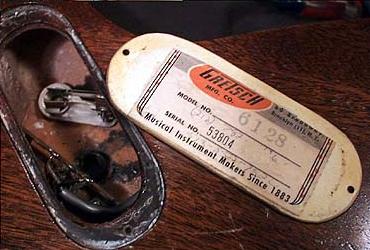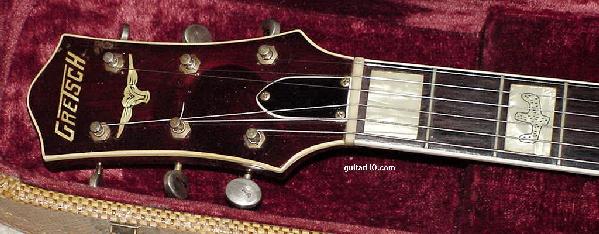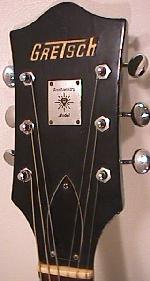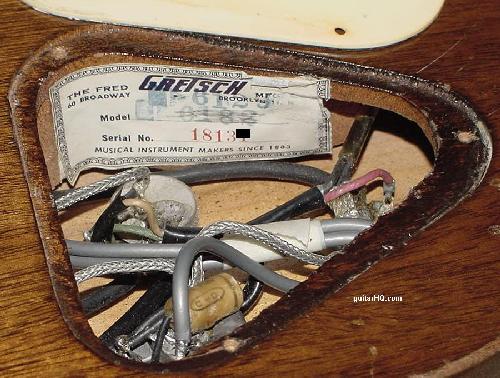Vintage Guitars Info's
Vintage Gretsch Guitars.
General Information and Specs.
Gretsch vintage guitars history and collecting. Private vintage guitar collector. Pictures, history for Gretsch vintage guitars.
Contact the Vintage Guitar Info Guy

- Introduction
- General Specs
- Model Numbers
- Serial Numbers
- Model info page and Schematics
- Picture Gallery, Gretsch section
Hollowbody Electric Archtop Models:
- 6120 Chet Atkins Hollowbody
- 6119 Chet Atkins Tennessean hollowbody
- 6122 Chet Atkins Country Gentlemen
- 6136 White Falcon
- 6192, 6193, 6196 Country Club
- Anniversary 6117/6118/6124/1625/6111/6112
- Monkees Electric Hollowbody
- 6079, 6080, 6081, 6082 Van Eps Electric Hollowbody
- 6199 Convertible or San Salvador
- Electromatic Spanish 6185, 6187, Corvette model
Hollowbody Acoustic Archtop Models:
Solidbody Models:
Flat top Models:
Introduction:
-
Collectible Gretsch instruments are mostly the models endorsed by Chet
Atkins made from 1954 to 1961 (single cutaway
models). Earlier models with western ornamentation ("cows & catus") are
the primary models desired.
Older Gretsch models (pre-1970) don't tend to hold up to time as well as other makes. Older binding materials and glues tend to deterior with age. This can cause expensive repairs such as neck sets and binding replacement. Additionally, Gretsch electronics (pickups, switch/knob layout) is not as sonically sound or versatile as those of other makers during the same period.

-
Despite the drawbacks, Gretsches from the mid 1950's have a certain "look"
that is undeniably cool. Models most highly regarded are the single cutaway
versions with western trim. Engraved position markers ("cow and cactus"),
the "G" brand, and western pickguards is what makes Gretsches valuable and
collectable. This especially applies to the 1954 to 1956 western models such
as the 6120 Chet Atkins hollowbody, the 6121 Chet Atkins solidbody, the 6130
Roundup and the 6022 Rancher.
The 6136 White Falcon and 6134 White Penguin from 1954 to 1957 are also highly collectable instruments. These have DeArmond pickups, engraved pearl position markers, vertical Gretsch logo, "Cadillac" tailpieces and gold sparkle binding. Unfortuneately, after 1957 many of these attributes disappear, making later models less desirable.
The appeal of solidbody Grestch guitars seems to be more "show" than go. That is they are collectable for their unusual looks, rather than for playing or sound. Gretsch solidbody really aren't solid, but are semi-hollow construction. The most collectable solidbody models are those with western ornamentation closely related to the most desirable hollowbody models. The Duojet, which has no hollowbody equivalent, is also collectable. The custom color and sparkle top models are worth more than the standard black or red top models.
-
Gretsch acoustic archtops appeal primarily to collectors only, as
players tend to steer clear of these models. Gretsch's
reputation is based more on their electric guitars than acoustic.
The quality of Grestch workmanship is not as good as Gibson and Epiphone
instruments from the same period. Due to poor material and/or construction
techniques, many older models haven't survived the test of time.
The high-end acoustic archtops
with "cat-eye" soundholes are visually appealing and collectible strickly
for their unusual looks. Other models with convential "F" holes are much
less desirable.
Gretsch flat tops tend to have inferior sound and playability compared to Gibson and Martin. The 6022 Rancher from 1954 to 1956 with "G" brand and engraved inlays is collectable, but mostly as an accessory to the other western models of the same period (6120, 6121, 6130). Other Gretsch models, though older and rarer, are less well known and are of little interest. The problem with Gretsch flat tops has to do largely with poor materials. Most use veneer (plywood) spruce tops with ladder bracing, opposed to solid spruce tops with "X" bracing that Gibson and Martin use.
The original Gretsch company based in Brooklyn, New York went out of business in 1981. Fred Gretsch III re-acquired the Gretsch name in the mid-1980's from Baldwin (which ran the brand into the ground and went out of business and stopped production by 1981). Then around 1990 Gretsch restarted production of Gretsch guitars in contract with Terada in Japan for the manufacturing for the Professional Series guitars. But Terada is just a factory-for-hire, and has no equity in Gretsch. Other guitar plants in Korea were contracted to build entry-level Gretsch lines (Historic, Electromatic, Synchromatic). In 2003, Mr. Gretsch contracted with Fender Musical Instrument Corporation (FMIC) to oversee manufacturing and marketing. FMIC has continued the relationship with Terada, and began a Gretsch Custom Shop in the US. Also mixed and matched Asian factories-for-hire (both Korean and Chinese) have been used to build the entry-level Electromatics. While many of the models built today observe "general" vintage Gretsch specifications, they aren't really "copies" of 1950s Gretsch guitar. The "new" Gretsches are actually a Gretsch in name, built under the auspices/ownership of the Gretsch family. Note many models not all are built towards replicating 50s guitar specs, though they rarely stray far from these original formulas.
Back to the Table of Contents
1946 to 1957 style Gretsch label (this label is
actually from 1956). Note "T" roof Gretsch logo.

1957 to 1964 style Gretsch label starting with
serial number 25001 (this label is actually from 1963).

Gretsch General Specs.
-
Labels
- 1946-1957: White rectangle label, "Fred Gretsch Mfg. Co. - 60 Broadway, Brooklyn, N.Y.", serial number in red, model number in blue or black. All models have this label by 1954.
- 1957-Early 1965: Gray top part, orange background for "The Fred Gretsch Mfg. Co.", beginning with serial number 25001.
- 1965-1972: No label, serial number on peghead.
- late 1960's: "That Great Gretsch Sound" across bottom of label, most with 5 digit serial number beginning with 1 or 2.
- 1972-1981: White label with black border, "Gretsch Guitars", no address.
- Script logo: introduced late 1930's, used on most models until mid 1954. Last script logos used on Synchromatics in late 1950's.
- "Grestch N.Y.C.", used in the 1930s and 1940s on low end models.
- "T" roof logo ("T" extends from "G" to "H"): introduced on some models in 1933 on the BroadKaster, mid 1940's for the New Yorker, and model 6003 flat top in 1951. All other models got this logo in mid 1954.
Beginning in the late 1940's, labels have serial number printed and model number written. On solidbody and closed hollowbody models, the label is on the backside of the control cover plate or in the control cavity.
Gretsch Logo
"neoclassic" inlays (right, 1960 Chet Atkins 6120). Also note the zero fret
just after the nut on the neoclassic inlay fingerboard (a zero fret was
not used on the earlier fingerboards, but an aluminum nut was!) And finally
the use of Brazilian rosewood on the humptop inlay fingerboard, and ebony
on the neoclassic board.

- Pre-1957: "Humptop" or block inlays on mid to upper line models. Humptop inlays are usually made from celluloid, and the block inlays can be either celluloid or pearl. In this era, humptop inlays are rare, with block inlays being the norm on mid to high end models. Low end models used dot inlays.
- 1955 to 1956 "Cowboy" Markers: On certain Chet Atkins and solidbody models (6120, 6121 and 6130 Roundup), Gretsch used block celluloid fingerboard inlays panographed with "Cows and Cactus". After panographed, the engraving is filled with gold paint (which quickly turns green and then black from playing). The Cow and Cactus inlays are probably one of Gretsch's coolest features, at least in my eye.
- 1957 to early 1958: "Humptop" celluloid inlays on mid to upper line models (block markers discontinued). As a general rule, humptop inlays on a Gretsch means 1957 or early 1958. Low end models still used dots.
- mid 1958 and later: "Neoclassic" or "thumb print" pearl inlays on mid to upper line models. Low end models still used dots.
Fingerboard Markers
Cow and Cactus fingerboard inlays on a 1955 Gretsch 6130 Roundup.
Often the inlay at the first fret is not engraved. The 3rd fret engraving
is a cactus on this guitar. Notice the peghead's engraved steerhead.

-
Truss Rod
- 1933 to 1951: No truss rod cover.
- 1951 to 1952: Truss rod adjustment at butt of neck by body.
- 1953 to 1955: Truss rod adjustment at peghead, small truss rod cover.
- 1956 to 1970: Truss rod adjustment at peghead, large bell-shaped truss rod cover.
- 1970 to 1980: No truss rod cover on peghead.
single Anniversary. Note the "T" roof
Gretsch logo, the bell-shaped truss rod
cover (as used in 1956 and later), and
the peghead name plate denoting
"Anniversary Model".

- Country Gentlemen: 1958 to 1970.
- Anniversary, Double Anniversary: 1958 to 1970.
- White Falcon: 1959 to 1970.
- Tennessean, Nashville: 1964 to 1970.
- Viking, Monkees: 1965 to 1970.
- Van Eps, Roc Jet, Streamliner: 1968 to 1970.
- Chet Atkins models: 1959 and later.
- Duo-Jets: 1962 and later.
- White Falcon, Country Club: 1963 and later.
- Sal Salvador, Astro jet: 1965 and later.
- Viking, Anniversary, Rally, Broadkaster, Rancher: 1968 and later.
- Clipper, Corvette: never got a zero fret.
Peghead Plates
Used on some models from 1958 to 1970. Square metal plate with engraved
model name. White Falcon and Country Gentlemen also have their serial
number on plate till 1965.
Zero Fret
This "feature" used a fret as the actual nut (though there was a nut too
for guiding the strings to the tuners only). Gretsch called this their
"Action-Flo" nut.
-
Gretsch Pickups and Bridges:
- 1949-1957: DeArmond Gretsch Dynasonic (Fidela-tone), single coil, black face, poles adjust by a separate set of screws. Because the screws and the poles are each in a separate row, these are often confused as being a "humbucker" pickup.
- 1957-1958: Filter'Tron, double coil (humbucker), 2 rows of poles, no markings on cover, smooth plastic frame.
- 1958-1960: Filter'Tron, "Pat. Applied For" stamped on cover, smooth plastic frame.
- 1960-1970: Filter'Tron, patent number 2892371 on cover, ridged plastic frame.
- 1961-1980: Hi-Lo'Tron: single coil, poles thru black face, low-end models only. Really a single coil version of the Filter'tron.
- 1970-1981: Filter'Tron, black face, no cover markings, height adjustable, open metal frame (same case as Hi-Lo'Tron).
- 1964-1980: Super'Tron: double coil, 2 metal bars (blades, no screw poles). Used on high end models like the Viking, Country Gent and Monkees.
- 1958-1959: Optional Project-o-Sonic stereo split stereo pickups, each pu with 3 pairs of poles on 1 side, bass/treble split. White Falcon and Country Club models only.
- 1959-1980: Optional Project-o-Sonic 4 switch system, 6 pairs of pole screws per pu, 4 switches on upper bass bout, many tone combinations. Used on White Falcon (1959-1980), Country Club (1960-1962), and Double Anniversary (1960-1962, 1 pu per channel) only.
- 1976-1980: DiMarzio or generic Japanese Humbucking pickup were used on some models, screw poles, metal cover.
DeArmond (upper left), Filter'tron (upper right),
HiLoTron (lower left), SuperTron (lower right).
The bridge in the upper right is a Melita,
and the bridges in the lower photos are Space Control bridges.

Pickups

-
Bridges
- 1930's: Ebony bridge on mid to high-end models.
- 1930's to 1980: Rosewood bridge on low-end models.
- late 1930's to 1953: Rosewood stairstep bridge with extended stairstep on bass side.
- 1951 to 1957: Melita bridge with individual adjustable intonation (intonation could be locked in place).
- 1954: Metal (Aluminum) Compensating Bigsby bridge. Seen mostly on Bigsby Chet Atkin models, a simple aluminum bridge without string intonation, this bridge was designed by Bigsby to be used with their tremolo system.
- 1958 to 1980: Metal bar bridge. Mostly seen on Chet Atkins models. No adjustment for intonation or string spacing.
- 1958 to 1980: Space control bridge. This was a metal threaded rod with individual rolling string guides to adjust string spacing. No adjustment for intonation.
- 1965 to 1972: Floating Tuning Fork bridge. Unattached to the body, tuning fork extends thru hole into body. Usually seen with Space Control bridge. Very unpopular and often removed.
- 1970 to 1980: Adjustamatic bridge. Much like Gibson's tuneamatic bridge.
1961 Gretsch catalog.

-
Tailpieces
- 1933 to 1980: Trapeze tailpiece used on many archtop models.
- 1930's to 1954: "Chromatic" Harp shaped tailpiece used on Synchromatic models.
- 1951 to 1980: "G" tailpiece with a "G" cutout.
- 1955: Bigsby vibrato with fixed arm.
- 1956 to 1958: Bigsby B-6 vibrato with rotating arm (DuoJets used the smaller B-3, and Corvettes used the horseshoe B-5 Bigsby).
- 1958 to 1980: Gretsch Bigsby B-6 vibrato, "V" cutout (Gretsch name now on the Bigsby tailpiece).
- 1963 to 1980: Burns vibrato with a 3 sided pyramid base and long arm.
- 1963 to 1968: Palm vibrato with a short arm.
-
Pickguards
- 1930's to 1980: many acoustic models use tortoise grain celluloid pickguard material.
- 1954 to 1980: many electric models have a 1/4" thick clear acyrlic plastic pickguard that is back-painted gold or silver.
- 1949 to 1954: Clear knobs, barrel shaped.
- 1954: Plain top, gold or chrome plated brass, cross-hatch pattern on side.
- 1955 to 1957: Arrow on top ("plain arrow"), gold or chrome plated brass, cross-hatch pattern on side.
- 1957 to 1967: Arrow thru a "G" on top, gold or chrome plated brass, cross-hatch pattern on side.
- 1966 to 1980: Aluminum knob, arrow thru "G" on top.
- 1961 to 1963: Single mute with 1 rotate knob (hollowbody Chet Atkins models only).
- 1961-1963: Double mute with 2 large rotary knobs. Used on White Falcons and Country Gentlemen only.
- 1963 to 1972: Single mute with 1 small lever knob. Used on Chet Atkins hollowbody models. Also used on Country Clubs (1963-1965), Country Gentlemen (1966-1971), and Viking (1968-1969).
- 1963 to 1972: Double mute with 2 small level knobs. Used on Country Gentlemen (1963-1966) and White Falcon (1963-1972).
Knobs (electrics)
Mutes
Back to the Table of Contents
Gretsch Model Numbers.
1955 Gretsch catalog.
-
1948 to 1975 Model Numbers
6000 Classic Hauser, inlaid peghead 6001 Classic Hauser, plain peghead 6002 Folk, sunburst 6003 Model 6003, 1951-1955 Grand Concert, 1955-1959 Jimmie Rodgers, 1959-1963 Folk Singer, 1963-1965 Folk, natural top, 1965-1975 6004 Burl Ives, 1952-1955 Folk, mahogany top, 1970-1975 6005 Ozark Soft String 6006 Electro Classic 6007 Synchormatic Sierra 6008 Wayfarer Jumbo 6009 Jumbo Flat top 6010 Sun Valley 6014 Synchromatic 100, sunburst, 1948-1949 Synchromatic 6014, sunburst, 1949-1955 Corsair, sunburst, 1955-1959 6015 Synchromatic 100, natural, 1948-1949 Synchromatic 6015, natural, 1949-1955 Corsair, natural, 1955-1959 6016 Corsair, Bordequx burgundy 6020 12-string flat top 6021 Jumbo Synchromatic model 125F, 1948-1955 6022 Rancher 6023 Bikini guitar 6024 Bikini bass 6025 Bikini double neck 6028 Synchromatic 160, sunburst 6029 Synchromatic 160, natural 6030 Synchromatic 6030, sunburst, 1951-1955 Constellation, sunburst, 1955-1959 Sho-Bro Spanish, 1969-1971 6031 Synchromatic 6031, natural, 1951-1955 Constellation, natural, 1955-1959 Sho-Bro Hawaiian, 1969-1971 6036 Synchromatic 300, sunburst, 1948-1951 Synchromatic 6036, sunburst, 1951-1955 6037 Synchromatic 300, 1948-1951 Synchromatic 6037, natural, 1951-1955 6038 Synchromatic 6038, sunburst, 1951-1955 Fleetwood, sunburst, 1955-1959 17" Eldorado, sunburst, 1959-1968 6039 Synchromatic 6039, natural, 1951-1955 Fleetwood, natural, 1955-1959 17" Eldorado, natural, 1959-1968 6040 Synchromatic 400, sunburst, 1948-1951 Synchromatic 6040, sunburst, 1951-1955 18" Eldorado, surburst, 1959-1968 6041 Synchromatic 400, natural, 1948-1951 Synchromatic 6040, natural, 1951-1955 18" Eldorado, natural, 1959-1968 6042 Synchromatic 400f flat top 6050 New Yorker 6070 Hollowbody bass, long scale, 1 pu 6071 Hollowbody bass, short scale, 1 pu 6072 Hollowbody bass, long scale, 2 pu 6073 Hollowbody bass, short scale, 2 pu 6075 12-string electric, sunburst 6076 12-string electric, natural 6079 Van Eps 7-string, sunburst 6080 Van Eps 7-string, walnut 6081 Van Eps 6-string, sunburst 6082 Van Eps 6-string, walnut 6100 Black Hawk, sunburst 6101 Country Club, stereo, sunburst, 1959-1963 Black Hawk, black, 1968-1972 6102 Country Club, stereo, natural, 1959-1963 Streamliner double cutaway, sunburst, 1969-1975 6103 Country Club, stereo, Cadillac Green, 1959-1963 Streamliner double cutaway, cherry, 1969-1975 6104 Rally, green 6105 Rally, bamboo yellow/cooper mist 6106 Princess 6111 Double Anniversary, stereo, sunburst 6112 Double Anniversary, stereo, 2-tone smoke green 6115 Rambler 6117 Double Anniversary, sunburst Custom cat's eye soundhole model, 1965-1968 6118 Double Anniversary, 2-tone smoke green 6119 Chet Atkins Tennessean 6120 Chet Atkins Hollowbody, 1954-1966 Nashville, 1967-1971 6121 Chet Atkins Solidbody 6122 Chet Atkins Country Gentlemen 6124 Anniversary, sunburst 6125 Anniversary, 2-tone smoke green 6126 Astro-Jet 6127 DuoJet Tenor, 1959 RocJet, Porsche Pumkin, 1969-1971 6128 DuoJet 6129 SilverJet 6130 Roundup, 1955-1959 RocJet, Mercedes Black, 1969-1973 6131 Jet FireBird 6132 Corvette Solidbody, 1 pu, no vibrato 6133 Corvette Solidbody, 2 pu, no vibrato 6134 White Penguin, 1955-1963 Corvette Solidbody, 1 pu, vibrato, 1963-1968 6135 Corvette Solidbody, 2 pu, vibrato 6136 White Falcon 6137 White Falcon, stereo 6145 Jet Airliner lapsteel 6147 Jet Mainliner lapsteel 6148 Jet Twin Console lapsteel, no legs 6148L Jet Twin COnsole lapsteel, 4 legs 6152 Electromatic Student lapsteel 6156 Electromatic Standard lapsteel 6158 Electromatic COnsole lapsteel 6182 Corvette hollowbody, sunburst 6183 Corvette hollowbody, natural 6184 Corvette holowbody, Jaguar Tan 6185 Electromatic Spanish, sunburst, 1949-1955 Clipper, 2 pu, sunburst, 1972-1974 6185N Electromatic Spanish, natural 6186 Clipper 6187 Electro II, non-cut, sunburst, 1951-1955 Corvette, ivory top, grey mist body, 1957 Corvette-style, cutaway, ivory top, grey mist body, 1958 Clipper, natural, 1959-1960 Viking, sunburst, 1967-1975 6188 Electro II, non-cut, natural, 1951-1955 Viking, natural, 1967-1975 6189 16" elctric cutaway, 2 pu, 1950-1955 Streamliner single cut, bamboo yellow/copper mist, 1955-1957 Viking, Cadillac Green, 1967-1972 6190 16" electric cutaway, 1 pu, sunburst, 1950-1955 Streamliner single cut, sunburst, 1955-1957 6191 16" electric cutaway, 1 pu, natural, 1950-1955 Streamliner single cut, natural, 1955-1957 6192 Electro II, cutaway, sunburst, 1951-1954 Country Club, sunburst, 1955-1971 6193 Electro II, cutaway, natural, 1951-1954 Country Club, natural, 1955-1971 6196 Country Club, Cadillac Green 6199 Convertible, 1955-1958 San Salvador, 1958-19681971 to 1981 Model Numbers
7176 Southern Belle 7505 Folk, sunburst 7506 Folk, natural 7514 Sun Valley, sunburst 7515 Sun Valley, natural 7525 Rancher 7535 Deluxe 7545 Supreme 7555 Clipper 7560 Double Anniversary, sunburst 7565 Streamliner, sunburst 7566 Streamliner, cherry 7575 Country Club, sunburst 7576 Country Club, natural 7577 Country Club, walnut 7580 Van Eps, 7-string, sunburst 7585 Viking, sunburst 7586 Viking, natural 7593 White Falcon, single cutaway 7594 White Falcon 7595 White Falcon, stereo 7600 Broadkaster solidbody, natural 7601 Broadkaster solidbody, sunburst 7603 Broadkaster hollowbody, bigsby, natural 7604 Broadkaster hollowbody, bigsby, sunburst 7605 Broadkaster bass, natural 7606 Broadkaster bass, sunburst 7607 Broadkaster hollowbody, no bigsby, natural 7608 Broadkaster hollowbody, no bigsby, sunburst 7609 Broadkaster hollowbody, red 7610 RocJet, black, 1971-1975 7611 RocJet, Porsche Pumpkin, 1971-1975 RocJet, black, 1975-1980 7612 RocJet, cherry 7613 RocJet, walnut 7615 Solidbody bass 7617 BST 1000, 2 pu, walnut 7620 Country Roc, 1974-1979 BST 2000, walnut, 1979-1980 7621 Roc II 7623 Corvette solidbody, 2 pu 7624 TK300, red 7625 TK300, natural 7626 TK300 bass, red 7627 TK300 bass, natural 7628 Committee 7629 Committee bass 7632 Deluxe Corvette 7635 Roc I 7655 Tennessean 7660 Nashville 7667 Streamliner II 7670 Country Gentlemen 7680 Deluxe Chet, red, 1973-1975 Atkins Super Axe, red, 1976-1980 7681 Deluxe Chet, walnut, 1973-1975 Atkins Super Axe, ebony, 1976-1980 7685 Atkins Axe, ebony 7686 Atkins Axe, red 7590 Super Chet, red 7691 Super Chet, walnut 7705 Sho-Bro Hawaiian, 6-string 7710 Sho-Bro Hawaiian, 7-string 7715 Sho-Bro Spanish 8210 BST1000, 1 pu, walnut 8211 BST1000, 2 pu, red 8215 BST1000, 2 pu, walnut 8216 BST1000, 1 pu, red 8217 BST1000, 2 pu, walnut 8220 BST2000, walnut 8221 BST2000, red 8260 BST5000Japanese Model Numbers, 1989 to Present
400 Synchromatic, similar to Synchromatic 400 6010 Sun Valley, triangle soundhole 6020 Crimson Flyer, electric acoustic, cutaway, triangle soundhole 6022 Rancher acoustic 6030 Nightbird, electric acoustic, cutaway, triangle soundhole 6119 Tennessee Rose, similar to Tennessean 6120 The Nashville 6120w The Nashville, western 6121 Round Up 6122s Country Classic I, single cut, similar to 1958 Country Gentlemen 6122 Country Classic II, double cut, similar to 1961 Country Gentlemen 6128 DuoJet 6129 SilverJet 6131 Jet FireBird 6136 White Falcon I, single cutaway, no vibrato 6175 Electric acoustic fretted bass 6176 Electric acoustic fretless bass 7593 White Falcon I, single cutaway, bigsby 7594 White Falcon II, double cutaway, bigsby
Back to the Table of Contents
Left: The serial number and "made in usa" stamp
on a November 1967 (the "107" part of the serial number)
model. This was the 58th instrument made that day.
Right: The serial number on a February 1967 (the "27"
part of the serial number) Chet Atkins Nashville 6120.
Note the lack of a "made in usa" stamp.


Gretsch Serial Numbers.
-
Only approximate year of manufacturer can be determined by Gretsch serial
numbers before 1965. It is best to date your pre-1965 Gretsch by serial
number and by specs. Although Gretsch's
during this period seem chronologically ordered (and in many cases are),
the numbers and labels often can not determine the exact year of
manufacture due to spec inconsistences.
The serial number on a 1963 Gretsch 6128 DuoJet,
under the backside control panel cover.

For example, two 1957 gretsch models could have consecutive serial number, but different specs. Examples include a later numbered model having humptop inlays and no zero fret (earlier specs), and an earlier numbered model having thumbprint inlays and a zero fret. This is the opposite of what the consecutive serial numbers would indicate.
The serial number on a 1958 Gretsch 6129 Silverjet single cutaway model.
Note the mistaken model number crossed off and restamped! It looks like
some of the wiring has been replaced on this Gretsch, which is very common
on 1950s Gretsch models. Often the wire's insulator cracks, shorting the wires.

-
1949 to 1965 Gretsch Serial Numbers.
-
Numbers are ink-stamped on the inside back or on the Gretsch label.
Most F-hole models have the label on the inside back, seen thru the f-hole.
Solidbody models with control plates on back have the label in the control
cavity. Sometimes the serial number is scratched on the inside control plate
of solidbody guitars. Sometimes the serial number is impressed on the
top edge of the peghead.
Number Year
2000 -3000's = 1949-1950
4000 -5000's = 1951
5000 -6000's = 1952
6000 -8000's = 1953
9000 -12000's = 1954
12000-16000's = 1955
17000-21000's = 1956
22000-26000's = 1957
27000-30000's = 1958
30000-34000's = 1959
34000-39000's = 1960
39000-45000's = 1961
46000-52000's = 1962
53000-63000's = 1963
63000-77000's = 1964
77000-84000's = 1964-early 1965 (partial-new number scheme
started early 1965).
1965 to 1972 Serial Numbers.
-
Number on back of peghead, or on the top edge of the peghead (prior to 1967),
no hypen in number. "Made in USA" stamped on back of peghead next to serial
number starting June 1967 to 1973.
First digit or first 2 digits = month (1-12). Next digit = last digit of the year (1965 to 1972: 5,6,7,8,9,0,1,2). Remaining digits = rank of individual instrument. Example: 118243 = November 1968, 243th instrument. 31041 = March 1971, 41th instrument. 993 = September 1969, 3rd instrument.1973 to 1981 Serial numbers.
-
Hyphenated number impressed into back of peghead.
1 or 2 digits before hyphen = month (1-12). First digit after hyphen = last digit of year. Last 3 digits = rank of instrument. Example: 10-5155 = October 1975, 155th instrument. 4-622 = April 1976, 22nd instrument.
to Gretsch Part 2
Back to the Table of Contents
Copyright 1995-2002 all rights reserved.